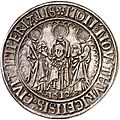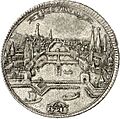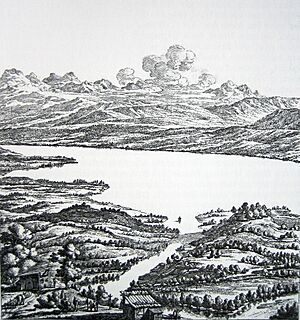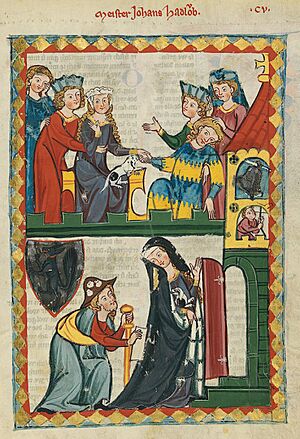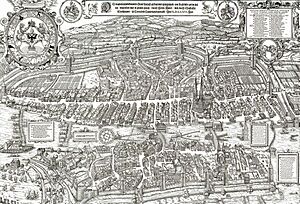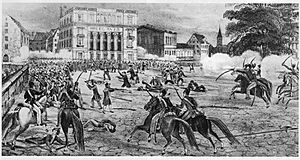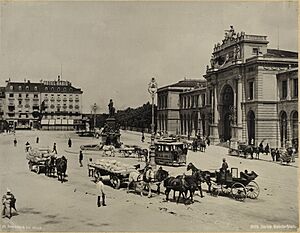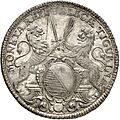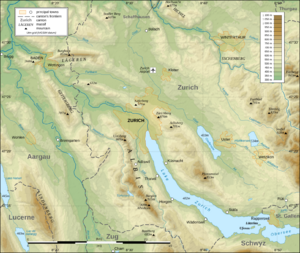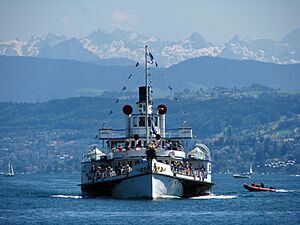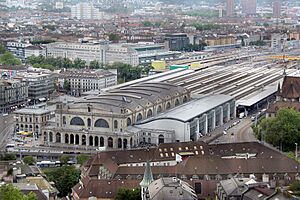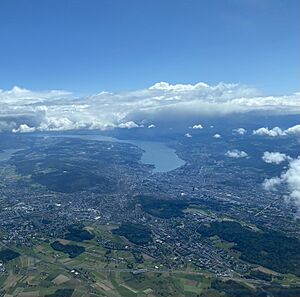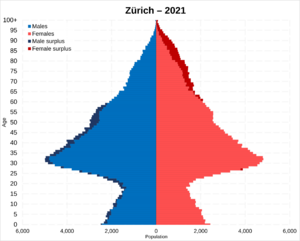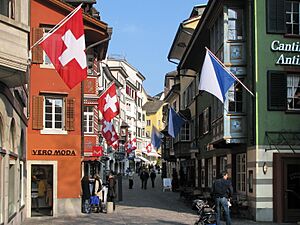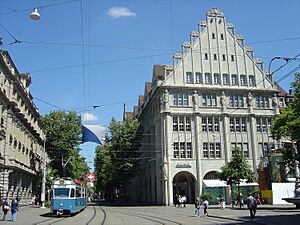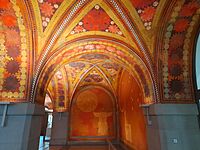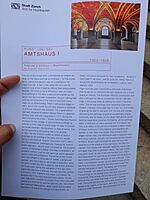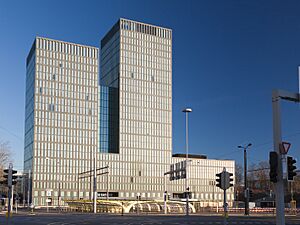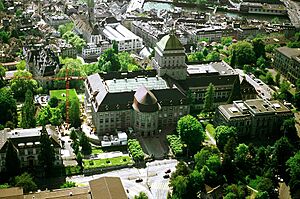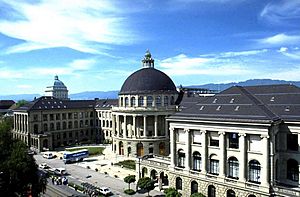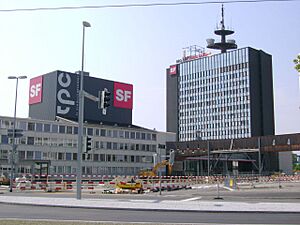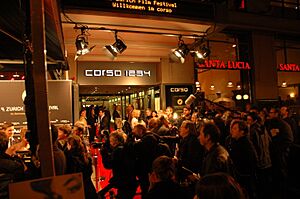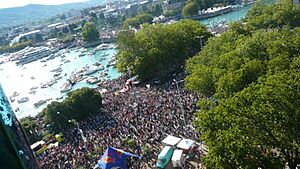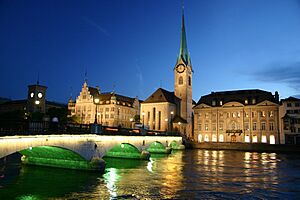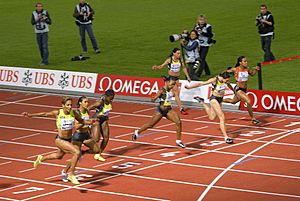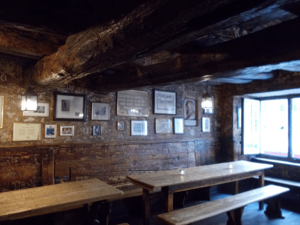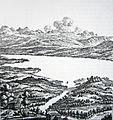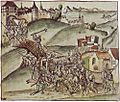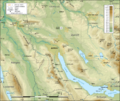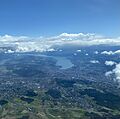Zurich facts for kids
Quick facts for kids
Zurich
|
|||
|---|---|---|---|
|
Municipality
|
|||
|
Zurich Opera House
Prime Tower
Dolder Grand
Old Town with Grossmünster, Fraumünster, St. Peter, Münsterbrücke and Limmat
|
|||
|
|||
| Country | Switzerland | ||
| Canton | Zurich | ||
| District | Zurich | ||
| Area
Lua error in Module:Wd at line 1575: attempt to index field 'wikibase' (a nil value).
|
|||
| • Total | Lua error in Module:Wd at line 1,575: attempt to index field 'wikibase' (a nil value). km2 (Formatting error: invalid input when rounding sq mi) | ||
| Elevation
(Zurich main railway station)
|
408 m (1,339 ft) | ||
| Highest elevation
(Uetliberg)
|
871 m (2,858 ft) | ||
| Lowest elevation
(Limmat)
|
392 m (1,286 ft) | ||
| Population
(2018-12-31)Lua error in Module:Wd at line 1575: attempt to index field 'wikibase' (a nil value).
|
|||
| • Total | Lua error in Module:Wd at line 1,575: attempt to index field 'wikibase' (a nil value). | ||
| Demonym(s) | German: Zürcher(in) | ||
| Time zone | UTC+01:00 (Central European Time) | ||
| • Summer (DST) | UTC+02:00 (Central European Summer Time) | ||
| Postal code(s) |
8000–8099
|
||
| SFOS number | Lua error in Module:Wd at line 1575: attempt to index field 'wikibase' (a nil value). | ||
| Surrounded by | Adliswil, Dübendorf, Fällanden, Kilchberg, Maur, Oberengstringen, Opfikon, Regensdorf, Rümlang, Schlieren, Stallikon, Uitikon, Urdorf, Wallisellen, Zollikon | ||
| Twin towns | Kunming, San Francisco | ||
| Website | SFSO statistics |
||
Zurich (German: Zürich; Alemannic German: Züri) is the largest city in Switzerland. It is also the capital of the canton of Zurich. The city is located in north-central Switzerland, at the northwestern tip of Lake Zurich. As of January 2023, Zurich had over 443,000 people living in it. The larger urban area has about 1.3 million people.
Zurich is a major center for trains, roads, and air travel. Both Zurich Airport and Zurich's main railway station are the biggest and busiest in Switzerland.
People have lived in Zurich for more than 2,000 years. The city was founded by the Romans, who called it Turicum. However, very old settlements have been found from over 6,400 years ago. This shows that people were in the area much earlier. During the Middle Ages, Zurich gained special independence. In 1519, it became a main center of the Protestant Reformation in Europe. This was led by Huldrych Zwingli.
The official language of Zurich is German. But most people speak Zurich German. This is a local version of the Alemannic Swiss German dialect.
Zurich is one of Switzerland's main financial centers. It has many banks and financial companies. You can find many museums and art galleries in the city. These include the Swiss National Museum and Kunsthaus. The Schauspielhaus Zürich is thought to be one of the most important theaters in the German-speaking world.
Contents
- Understanding the Name of Zurich
- Zurich's Long History
- Zurich's Location and Landscape
- Getting Around Zurich
- People and Life in Zurich
- Top Places to See in Zurich
- Zurich's Economy
- Learning and Research in Zurich
- Media in Zurich
- Zurich's Culture and Fun
- Sports in Zurich
- Other Interesting Places
- Images for kids
- See also
Understanding the Name of Zurich
The name of the city is usually written in English as Zurich. It does not have the two dots (umlaut) over the 'u'.
In German, the city's name is written Zürich. In the local dialect, Züri, it is pronounced without the last sound. In French, it is called Zurich. In Italian, it is Zurigo. In Romansh, it is Turitg.
The oldest known name for the city is Turicum. This name was found on a tombstone from the late 100s AD. It was part of a phrase meaning "Turicum customs post." The name probably comes from an old Gaulish (Celtic) personal name, Tūros. So, *Turīcon would mean "place of Tūros."
The name started to change towards its German form around 680–700 AD. It was then called Ziurichi. From the 9th century on, the name became Zuri(c)h.
Zurich's Long History
Early Beginnings
People lived around Lake Zurich during the Neolithic (New Stone Age) and Bronze Age. Signs of early Celtic settlements were found near the Lindenhof. This is a small hill overlooking the lake and the Limmat river.
In Roman times, around 15 BC, the Romans built a small fort called a castellum on the Lindenhof. Later, a tax collection point called Turicum was set up there. This point collected taxes on goods moved on the Limmat river. The river was part of the border between different Roman areas. This tax point grew into a small town. The oldest written record of the town is from the 2nd century. It mentions "Zurich post for collecting the 2.5% value tax of the Galliae."
In the 5th century, the Germanic Alemanni tribe settled in the area. The Roman fort stayed until the 7th century. A new castle was built on the same spot in 835 by Louis the German, a grandson of Charlemagne. Louis also founded the Fraumünster abbey in 853 for his daughter Hildegard. He gave the abbey land and special rights. This made the abbess (the head nun) the ruler of the city. In 1045, King Henry III gave the abbey rights to hold markets, collect tolls, and make coins.
Zurich became an Imperial free city in 1218. This meant it was independent and answered directly to the Holy Roman Emperor. It was like becoming its own small state. In the 1230s, a city wall was built around 38 hectares of land. The old Carolingian castle was used for stones to build new houses.
Emperor Frederick II made the abbess of the Fraumünster a duchess in 1234. The abbess chose the mayor and often let citizens make coins. But the power of the abbey slowly decreased in the 14th century. This started when Rudolf Brun created new guild laws in 1336. He became the first mayor not chosen by the abbess.
An important event in the early 1300s was the finishing of the Manesse Codex. This book is a key source of medieval German poetry. This famous illuminated manuscript was made in Zurich between 1304 and 1340. Creating such a work was very expensive and needed skilled artists. It showed how rich and proud the citizens of Zurich were becoming.
The first mention of Jews in Zurich was in 1273. There was a synagogue in the 13th century, meaning a Jewish community existed. When the Black Death arrived in 1349, Zurich, like many other Swiss cities, treated the local Jews badly. This ended the first Jewish community there. A second Jewish community formed later in the 14th century. But it was short-lived, and Jews were banned from the city from 1423 until the 1800s.
Old Discoveries
In March 2017, during a construction project, a woman who died around 200 BC was found. She was buried in a carved tree trunk. Archaeologists found she was about 40 years old and likely did not do much hard physical work. A sheepskin coat, a belt chain, a wool dress, a scarf, and a pendant made of glass and amber beads were also found with her.
Joining the Swiss Confederacy
On May 1, 1351, the people of Zurich joined the Old Swiss Confederacy. This was a group of independent states. Zurich became the fifth member. From 1468 to 1519, Zurich was the leading canton in the Diet. This was the main council and lawmaking body of the confederacy. Zurich was temporarily kicked out of the confederacy in 1440. This was due to a war with other members over the Toggenburg area (the Old Zurich War). Peace was made in 1446, and Zurich rejoined in 1450.
Zwingli started the Swiss Reformation in 1519. He was the main preacher at the Grossmünster church. The Zurich Bible was printed in 1531. The Reformation brought big changes to Zurich's government and daily life. It also spread to other cantons. Some cantons stayed Catholic, which led to serious conflicts and wars. Zwingli died defending Zurich in the Battle of Kappel. Heinrich Bullinger then became the city's spiritual leader.
During the 16th and 17th centuries, Zurich's council became more isolated. They built a second ring of strong walls in 1624. These walls were built because of the Thirty Years' War happening across Europe. Building them took many resources from nearby areas without agreement. Rebellions were put down harshly. In 1648, Zurich declared itself a republic. It was no longer a free imperial city. At this time, Zurich was ruled by a few powerful families.
The Helvetic Revolution in 1798 changed everything. Zurich lost control of its lands and special economic rights. The city and canton separated their properties between 1803 and 1805. In 1839, the city had to give in to demands from its rural areas. This happened after the Züriputsch on September 6. Most of the 17th-century walls were torn down. This was to calm fears that the city was too powerful. The Treaty of Zurich was signed in 1859.
Modern Zurich
Zurich was the capital of the Swiss Confederation in 1839–40 and again in 1845–46. Big changes happened in the 19th century. In 1847, the Spanisch-Brötli-Bahn opened. This was the first railway in Switzerland. It connected Zurich with Baden. This made the Zürich Hauptbahnhof the start of the Swiss rail network. The current main station building dates from 1871. Zurich's Bahnhofstrasse (Station Street) was built in 1867. The Zurich Stock Exchange started in 1877. More industries led to more people moving to cities. This caused fast population growth, especially in Zurich's suburbs.
The Quaianlagen were important for modern Zurich. These new lakefront areas changed Zurich from a small medieval town to a modern city. This was guided by city engineer Arnold Bürkli.
In 1893, twelve nearby areas became part of Zurich. This included Aussersihl, a working-class area. More land was also taken from Lake Zurich. In 1934, eight more areas in the north and west were added.
Zurich was accidentally bombed during World War II. When Jews sought safety in Switzerland, the SIG helped raise money. The Central Committee for Refugee Aid was in Zurich.
The canton of Zurich did not officially recognize Jewish religious groups until 2005.
Zurich's Coat of Arms
The coat of arms of Zurich is used by both the city and the canton. It has a white and blue shield. It first appeared in the 1300s. The earliest record is from a seal in 1384. The shield was shown in color on a flag in 1437.
When the canton of Zurich was created in 1803, it used the same coat of arms. A new version for the city added a crown on top. The city and canton also have slightly different supporters (animals holding the shield). Both have two lions. But the canton's lions hold a sword and a palm leaf.
Zurich's Location and Landscape
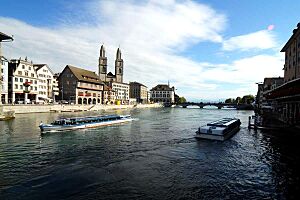
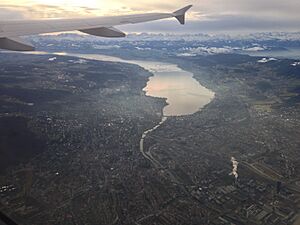
Zurich is located about 408 meters (1,339 feet) above sea level. It is at the northern end of Lake Zurich. The city is about 30 kilometers (19 miles) north of the Alps. It sits between wooded hills on its east and west sides. The Old Town is on both sides of the Limmat river. The river flows from the lake and then turns west. The historic center of the city is the Lindenhof. This is a small hill on the west bank of the Limmat.
Today, the city extends beyond the hills. It includes areas in the northeast (the Glatt Valley) and north (the Limmat Valley). The older city limits are easy to see by the Schanzengraben canal. This canal was part of the city's defenses in the 17th and 18th centuries.
City's Shape and Features
The municipality of Zurich covers 91.88 square kilometers (35.48 sq mi). About 4.1 square kilometers (1.6 sq mi) of this is Lake Zurich. The area includes part of the northern Swiss Plateau. The banks of the Limmat river are the most densely built-up part of the city. The river valley is about 2 to 3 kilometers (1.2 to 1.9 miles) wide. The Limmat river flows along the right (northeastern) side of the valley. The Sihl river joins the Limmat at Platzspitz park. The lowest point in the city is 392 meters (1,286 feet) above sea level.
On its west side, the Limmat valley has the wooded Albis hills. The Uetliberg is the highest point nearby, at 869 meters (2,851 feet) above sea level. You can easily reach its top by train. From the observation tower, you can see amazing views of the city, the lake, and the Alps.
The northeast side of the Limmat valley has a range of hills. These hills separate the Limmat and Glatt valleys. From northwest to southeast, these wooded hills include the Gubrist (615 m), Hönggerberg (541 m), Käferberg (571 m), Zürichberg (676 m), Adlisberg (701 m), and Öschbrig (696 m). The Milchbuck area (about 470 m) is an important pass between the Limmat and Glatt valleys.
The northernmost part of the city reaches the Glatt valley plain. It also includes parts of the Katzensee (a nature reserve) and Büsisee lakes. These lakes drain into the Glatt river.
Zurich's Weather
Zurich has an oceanic climate. This means it has warm summers and four clear seasons. Winds from the west often bring rain. The Bise (east or northeast wind) usually brings cooler, clear weather. The Foehn wind, a warm, dry wind, also affects Zurich.
The average yearly temperature at the Zurich-Fluntern weather station is 9.3°C (48.7°F). This station is on the slope of the Zürichberg. The coldest month is January, with an average low of -2.0°C (28.4°F). The warmest month is July, with an average high of 24.0°C (75.2°F).
On average, there are about 75 days a year when the temperature drops below 0°C (32°F). There are also about 24 days when the temperature stays below 0°C (32°F) all day. Zurich has about 30 "summer days" (above 25°C or 77°F) each year. About 6 days are "heat days" (above 30°C or 86°F).
The average high temperature in July is 24.0°C (75.2°F). The average low is 14°C (57°F). The highest temperature ever recorded in Zurich was 37.7°C (99.9°F) in July 1947.
Spring and autumn are usually cool to mild. But temperatures can change a lot, even in the same year. Zurich gets about 1,544 hours of sunshine each year. This is about 38% of the possible sunshine. It rains about 1,134 mm (44.6 inches) on 134 days a year. This means it rains about every third day.
Climate Change in Zurich
Zurich's climate is getting warmer and wetter. It also gets less sunlight. Comparing 1940-1950 to 2013-2024 shows big changes. For example, July temperatures have risen by 1.77°C (3.19°F). December has seen a rise of 3.41°C (6.14°F). Rainfall in October has increased by 1.45 mm (0.06 inches). Snowfall in February has decreased. Sunshine in March has also gone down.
Protecting the Climate
In November 2008, the people of Zurich voted. They decided to make a law to reduce CO2 emissions. The goal is to reach one tonne of CO2 per person per year by 2050. This means all city decisions must support this goal, even if it costs more. Examples include building energy-efficient hospitals. They also work on improving public transport and bicycle paths. The city supports research into renewable energy.
City's Green Spaces
The areas around the Limmat river are mostly built up. They have homes, factories, and businesses. The hills overlooking Zurich, like Waidberg and Zürichberg, also have many buildings.
The city's "green lungs" are the large forest areas. These include Adlisberg, Zürichberg, Käferberg, Hönggerberg, and Uetliberg. Big parks are along the lake (Zürichhorn and Enge). Smaller parks are found throughout the city. Large farming areas are near Affoltern and Seebach. About 45% of Zurich's land is for homes, industry, and businesses. Forests make up 26.5%, and agriculture is 11%.
Getting Around Zurich
Public Transportation
Public transport is very popular in Zurich. Many people use it. About 70% of visitors use the tram or bus. About half of all trips within the city are by public transport. The ZVV public transport network includes trains (like the S-Bahn local trains), Zurich trams, and buses. It also has boats on the lake and river. There are also funicular railways and a cable car (the Luftseilbahn Adliswil-Felsenegg). A single ticket is valid on all these types of transport. The Zürichsee-Schifffahrtsgesellschaft (ZSG) runs passenger boats on the Limmat river and Lake Zurich. They connect towns between Zurich and Rapperswil.
Zurich is a major hub for trains, roads, and air travel. Zürich Hauptbahnhof (Zurich HB) is the largest and busiest train station in Switzerland. It is an important railway hub in Europe. In early 2020, Zurich HB served about 470,000 passengers and nearly 3,000 trains daily. There are 16 train stations within Zurich's city limits. Five of them are major passenger stations. These include Stadelhofen, Oerlikon, and Altstetten. The train network is mainly run by the Swiss Federal Railways (SBB CFF FFS). Zurich is also served by major international trains from nearby countries.
Zurich Airport
Zurich Airport is less than 10 kilometers (6 miles) northeast of the city. It is located in Kloten. Zurich Airport has its own underground train station. It connects directly to Zurich and most major Swiss cities. Over 60 airlines from around the world fly to Zurich Airport. It is also a hub for Swiss International Air Lines. There is also a smaller airfield in Dübendorf.
Driving in Zurich
The A1, A3, and A4 motorways pass near Zurich. The A1 goes west towards Bern and Geneva and east towards St. Gallen. The A4 goes north to Schaffhausen and south to Altdorf. The A3 goes northwest towards Basel and southeast along Lake Zurich.
Cycling in Zurich
In 2012, the city started a plan to make cycling better. This "Masterplan Velo" aims to increase cycling and make it safer. The city wants to double the number of bike trips by 2015. They also want to lower accident risks for cyclists. Cycling should become an everyday way to travel, especially for children and young people.
The city plans to build a network of clear bicycle routes. This network will have main routes for daily use and comfort routes for fun cycling. Other plans include special "Velostationen" (bike stations) with bike services. A key project is a tunnel under the main railway station tracks. This tunnel would connect routes and offer staffed bike parking. The city also plans to improve communication, education, and administration for cycling.
However, these efforts have faced criticism for being slow. The bike tunnel at the main station, planned for 2016, was delayed to at least 2019. Some groups question if the plan is working. They point to poor traffic management at construction sites and not enough bike parking. The city department in charge says they invest a lot each year. They also say ongoing discussions will lead to better results.
People and Life in Zurich
Population Details
Zurich is Switzerland's largest city, with over 443,000 people living there. In 2016, about 32% of residents (133,473 people) were not Swiss citizens. Germans were the largest group, making up 8% of the total population. Italians were the second largest group. In 2011, the city and its suburbs had 1.17 million people. The entire metropolitan area had about 1.82 million people.
| Nationality | Number | % total (foreigners) |
|---|---|---|
| 33,548 | 8.1% (25.1%) | |
| 14,543 | 3.5% (10.9%) | |
| 8,274 | 2.0% (6.2%) | |
| 6,207 | 1.5% (4.7%) | |
| 4,809 | 1.2% (3.6%) | |
| 4,244 | 1.0% (3.2%) | |
| 3,597 | 0.9% (2.7%) | |
| 3,483 | 0.8% (2.6%) | |
| 3,402 | 0.8% (2.5%) | |
| 2,437 | 0.6% (1.8%) | |
| 2,126 | 0.5% (1.8%) |
Languages Spoken
The official language used in schools, news, and government is Swiss Standard German. However, most people speak Zurich German (Züritüütsch). This is a local dialect of Swiss German. Because Zurich is so important, people from all over Switzerland live and work there. So, many different Swiss German dialects are spoken.
In 2010, 69.3% of people spoke Swiss German/Swiss Standard German at home. About 22.7% spoke Standard German at home. English speakers have increased a lot, now at 8.8%. Italian is spoken by 7.1%, and French by 4.5%. Other languages include Bosnian (4.1%), Spanish (3.9%), Portuguese (3.1%), and Albanian (2.3%). Many people speak two or more languages at home.
Religions in Zurich
| Religion in Zurich – 2010 | ||||
|---|---|---|---|---|
| Religion | Nationality | Total-Pop. | ||
| Roman Catholic | Swiss | 28% | 30% | |
| Other | 35% | |||
| Unaffiliated | Swiss | 25% | 27% | |
| Other | 31% | |||
| Swiss Reformed | Swiss | 33% | 26% | |
| Other | 9% | |||
| Other Christians | Swiss | 6% | 7% | |
| Other | 9% | |||
| Islam | Swiss | 3% | 5% | |
| Other | 9% | |||
| Other Religion | Swiss | 2% | 2% | |
| Other | 4% | |||
| No answer | Swiss | 2% | 2% | |
| Other | 2% | |||
| Jewish | Swiss | 1% | 1% | |
| Other | 1% | |||
Before the Protestant Reformation, Zurich was mostly Roman Catholic. The Reformation, led by Huldrych Zwingli, made Zurich a center for Protestantism in Switzerland. Zwingli translated the Bible into German. He brought the Reformation to Zurich with the support of leaders and the people. The canton adopted the Reformed faith. Religious wars between Catholics and Protestants happened in Switzerland. Zwingli died defending Zurich in battle. Heinrich Bullinger then became the city's spiritual leader.
In 1970, about 53% of people were Swiss Reformed. Almost 40% were Roman Catholic. Since then, both churches have lost members. In 2010, 30% were Roman Catholic and 26% were Swiss Reformed. In 1970, only 2% said they had no religion. By 2000, this rose to 17%. In the last ten years, it went up to over 25%. For people aged 24 to 44, it's as high as one in three.
About 5% of Zurich's people are Muslims. The Mahmood Mosque Zurich was the first mosque built in Switzerland. The number of Jewish people has stayed about 1% since 1970. The Synagoge Zürich Löwenstrasse is Zurich's oldest and largest synagogue.
Quality of Life
Zurich often ranks very high in international surveys for quality of life. The consulting firm Mercer has often ranked Zurich as a city with the highest quality of life in the world. Zurich scores well for work, housing, free time, education, and safety. City planners keep urban and natural areas separate. There are many protected nature reserves. Zurich is also ranked as one of the most expensive cities in the world.
Zurich benefits from high spending on education. This provides skilled workers at all levels. The city has two major universities. This gives access to educated people and advanced research. Professional training combines hands-on work and school study. People generally have a good education and language skills. This means employees are motivated and rarely miss work. Also, employment laws are less strict than in nearby countries.
Google Zurich is a main center for its work in Europe. It has about 5000 employees. In March 2023, workers there supported a union effort. They wanted to reduce layoffs and stop pay cuts. Google said Zurich would remain an important employer despite these changes.
The Swiss Stock Exchange
The Swiss stock exchange is called SIX Swiss Exchange. It used to be known as SWX. It is the main group for several financial systems worldwide. In 2007, the exchange handled 1,780,499.5 million Swiss francs in trades. The number of trades was over 35 million.
Top Places to See in Zurich
Most of Zurich's famous places are along the Limmat river. They are between the Main railway station and Lake Zurich . The churches and old houses are here. So are the most expensive shops on the famous Bahnhofstrasse. The Lindenhof in the old town is where the Roman fort and later Imperial Palace once stood.
Important Churches
- Grossmünster (Great Minster): Legend says Charlemagne found the graves of martyrs here and built the first church. The current building started around 1100. In the early 1500s, it was the starting point of the Swiss Reformation led by Huldrych Zwingli. It was declared an imperial church by Charlemagne. It has old Romanesque parts and beautiful modern windows.
- Fraumünster (Women's Minster): This church was part of an abbey for noble women. It was founded in 853 by Louis the German for his daughter. The oldest parts of the church are from before 874. The Romanesque choir is from 1250 to 1270. The church had royal support and the right to make coins until the 13th century. After the Reformation, the city took over the church. Its most important features are its colorful windows. Some are by Augusto Giacometti (1945). Others are a five-part series (1970) and a rose window (1978) by Marc Chagall. It also has the largest organ in the canton.
- St. Peter: This church has Romanesque, Gothic, and Baroque styles. It was built on older church remains from before the 9th century. It has the largest church clock face in Europe, built in 1538. Inside, you can see a baptismal font from 1598 and beautiful Baroque decorations.
- Predigerkirche: This is one of the four main churches in the old town. It was first built in 1231 as a Romanesque church for the Dominican Predigerkloster (monastery). It was rebuilt in the 1300s. Its tall bell tower made it one of the highest Gothic buildings in Zurich at the time.
Interesting Museums
- Zürich Museum of Art: This is one of Europe's important art museums. It has one of the world's largest collections of Classic Modern art. This includes works by Munch, Picasso, Braque, and Giacometti. The museum also has a large collection of photographs.
- Swiss National Museum: The National Museum (German: Landesmuseum) shows many items about Switzerland's culture and history. It has old artifacts like stained glass, costumes, painted furniture, and weapons. The museum is in Platzspitz park, across from the Main Station.
- Centre Le Corbusier: Located by Lake Zurich, this museum is about the work of Swiss architect Le Corbusier. It is inside the last house he designed.
- Rietberg Museum: The Rietberg Museum is a great place for art and culture in Zurich. It shows exhibits from around the world. These include bronze items from Tibet, Indian sculptures, and African masks.
- Museum of Design: This museum focuses on industrial design, visual communication, architecture, and crafts. It is part of the Zurich University of the Arts.
- Haus Konstruktiv: This museum is known in Switzerland and internationally. It is about constructive, concrete, and conceptual art and design. It is located near the Main Station.
- Uhrenmuseum Beyer: The Uhrenmuseum is in the city center. It shows the history of timekeeping. The museum has many mechanical clocks and watches. It also has old timekeeping tools like water clocks and sundials.
- No Show Museum: This museum is unique. It is the first museum dedicated to "nothing" and how it has appeared in art history.
- Guild houses: These old buildings are along the Limmat river. Many of them are now museums or have special exhibits. For example, the Meisen is a porcelain museum.
- Tram Museum: This museum is in Zurich's eastern suburbs. It tells the story of Zurich's famous tram system. It has exhibits from 1897 to today.
- North America Native Museum: This museum focuses on the art and objects of Native American, First Nation, and Inuit cultures.
- FIFA Museum: This museum shows items from the world of football (soccer). It was founded by the Fédération Internationale de Football Association.
Parks and Nature Spots
- Zoological Garden: The zoo has about 260 animal species and around 2200 animals. You can see snow leopards, Indian lions, and pandas here.
- Botanical Garden: This garden has about 15,000 types of plants and trees. It holds as many as three million plants. You can find rare plants from Africa and New Caledonia here. The University of Zurich owns the Botanical Garden.
- Chinese Garden: This garden was a gift from Zurich's Chinese partner city, Kunming. It celebrates Zurich's help with Kunming's water supply. The garden shows a main idea of Chinese culture: the "Three Friends of Winter." These are pine, bamboo, and plum, which stay strong in cold weather.
- Uetliberg: This is the highest hill west of the city, at 813 meters (2,667 feet) above sea level. It offers great views over the city. You can easily reach the top by train from Zurich main station.
Art in Public Buildings
In 1922, Augusto Giacometti won a contest to paint the entrance hall of Amtshaus I. The city wanted to brighten this dark room, which was once a cellar. They also wanted to help local artists. Giacometti worked with other painters to create a unique, colorful space. It feels almost sacred because of its bright light.
Zurich's Buildings
Zurich has fewer tall buildings compared to other cities. City rules limit high-rise buildings to areas in the west and north. In industrial areas, buildings up to 80 meters (262 feet) are allowed. In nearby areas, the height is limited to 40 meters (131 feet). Around 2000, rules became more flexible. New tall buildings were planned and built. In 2009, people voted against a plan to reduce building heights. At that time, about a dozen tall buildings were being built or planned. This included the Prime Tower, which was the tallest skyscraper in Switzerland when it was built. There are also many examples of brutalist buildings, like the Swissmill Tower. At 118 meters (387 feet), it is the world's tallest grain silo.
World Heritage Sites
Some prehistoric settlements in Zurich are part of a UNESCO World Heritage Site. These are the pile dwellings at Enge Alpenquai, Grosser Hafner, and Kleiner Hafner. These sites are called the Prehistoric Pile dwellings around the Alps.
Zurich's Economy
Zurich produces about 10% of Switzerland's total economic output. About 90% of workers are in the service sector.
In a 2009 survey, Zurich was ranked 9th among the "World's 10 Most Powerful Cities." In 2017, Zurich was the 11th most competitive financial center in the world. It was second in Europe after London. The Greater Zurich Area is Switzerland's economic center. Many international companies have offices there.
Some of Switzerland's largest financial companies are based in Zurich. These include UBS, Credit Suisse, Zurich Cantonal Bank, Migros Bank, Julius Baer, Zurich Insurance Group, Swiss Re, and Swiss Life.
Why Zurich's Economy is Strong
Zurich's high quality of life helps its economy grow. The consulting firm Mercer has often ranked Zurich as having the best quality of life in the world. Zurich scores high for work, housing, leisure, education, and safety. City planners make sure urban and natural areas are separate. There are many protected nature reserves. Zurich is also ranked as one of the most expensive cities in the world.
Zurich invests a lot in education. This provides skilled workers at all levels. The city has two major universities. This gives access to educated people and advanced research. Job training combines practical work with academic study. People usually have a good general education and language skills. This means employees are motivated and rarely miss work. Also, employment laws are less strict than in nearby countries.
The Swiss Stock Exchange
The Swiss stock exchange is called SIX Swiss Exchange. It used to be known as SWX. It is the main group for several financial systems worldwide. In 2007, the exchange handled 1,780,499.5 million Swiss francs in trades. The number of trades was over 35 million.
Learning and Research in Zurich
In 2019, about 70,000 people studied at Zurich's 20 universities and colleges. Two of Switzerland's most famous universities are in the city. These are the Swiss Federal Institute of Technology (ETH Zurich) and the University of Zurich. ETH Zurich is run by the federal government. The University of Zurich is run by the canton of Zurich. Both universities were in the top 50 world universities in 2007. ETH has been in the top 10 worldwide since 2016.
ETH was founded in 1854 and opened in 1855. It is known for chemistry, math, and physics. Twenty-one Nobel Prize winners are connected to ETH. ETH is usually ranked the best university in continental Europe. It has two campuses: a main building in the city center and a new campus outside the city.
The University of Zurich was founded in 1833. It started as a theology college in 1525. Today, it is the largest university in Switzerland, with 24,000 students. It offers the widest range of subjects in Swiss higher education.
Other top colleges in Zurich include the Pedagogical College, the Zurich University of Applied Sciences (ZHAW), and the Zurich University of the Arts (ZHdK). These schools do applied research and development. Zurich is also a center for the European Institute of Innovation and Technology.
Besides university libraries, the city has the Zentralbibliothek Zürich. This is a research and public library. The Pestalozzi-Bibliothek Zürich is a public library with 14 locations.
University Sizes in Zurich Canton
| School Name | Total Students |
|---|---|
| University of Zurich – UZH | 25,618 |
| Swiss Federal Institute of Technology Zurich – ETH | 20,607 |
| Zurich University of Applied Sciences – ZHAW | 15,334 |
Media in Zurich
Many large Swiss media companies have their main offices in Zurich. These include tamedia, Ringier, and the NZZ-Verlag.
TV and Radio
The main office for Switzerland's national German-language TV network ("SF") is in Zurich. The regional TV station "TeleZüri" is also based here. Other TV stations like "Star TV" and "3+" have production facilities nearby.
One part of the Swiss German-language public radio station "Schweizer Radio DRS" is in Zurich. There are also local commercial radio stations. These include "Radio 24" and "Energy Zurich." Some radio stations only broadcast at certain times of the year.
Newspapers and Magazines
Three large daily newspapers are published in Zurich and known across Switzerland. These are the Neue Zürcher Zeitung (NZZ), the Tages-Anzeiger, and Blick. Blick is the largest Swiss tabloid newspaper. All three also publish Sunday editions. There is also a free daily commuter newspaper called 20 Minuten (20 minutes). It is given out widely on weekdays.
Many magazines from major publishers are based in Zurich. Some examples are Bilanz, Die Weltwoche, Annabelle, and Schweizer Illustrierte.
Zurich's Culture and Fun
Zurich has great museums and art galleries. It also has high-quality orchestras and important theaters.
The Zurich Film Festival is an international film festival. It lasts 11 days and shows popular international movies.
One of the biggest and most popular yearly events is the Street Parade. It is one of the largest techno and dance music festivals in the world. It takes place along Lake Zurich, usually on the second Saturday in August. The first one was in 1992 with about 1,000 people. By 2001, it attracted one million people. The Zürifäscht is a public festival held every three years. It has music, fireworks, and other attractions in the old town. It is Switzerland's largest public festival, drawing up to 2 million visitors.
The Kunst Zürich is an international contemporary art fair. It shows new art and works by well-known artists. Another yearly public art show is the city campaign. It features decorated sculptures placed in public areas around the city center. Past themes have included lions, cows, benches, and teddy bears. This idea led to the CowParade seen in other major cities.
Zurich has been home to several art movements. The Dada movement started in 1916 at the Cabaret Voltaire. Artists like Max Bill and Marcel Breuer had studios in Zurich. This became even more important during World War II.
The most famous traditional holiday is the Sechseläuten (Sächsilüüte). It includes a parade of the guilds. They also burn a figure representing "winter" at the Sechseläutenplatz. During this festival, the popular Sechseläutenmarsch song is played. Another event is the Knabenschiessen target shooting competition for teenagers. It was originally for boys but opened to girls in 1991.
Opera, Ballet, and Theaters
The Zurich Opera House (German: Zürcher Opernhaus) was built in 1834. It was the first permanent theater in Zurich. It was also a main place for Richard Wagner's work. In 1890, the theater was rebuilt in a beautiful neo-classical style. The front has white and gray stone with busts of famous composers. The inside is in the rococo style. Once a year, it hosts the Zürcher Opernball. The Ballett Zürich performs at the opera house. The Zurich Opera Ball is a big social event. It raises money for the opera and ballet companies.
The Schauspielhaus Zürich is the city's main theater. It has two locations: Pfauen in the city center and Schiffbauhalle in Zurich West. The Schauspielhaus was a home for writers like Bertolt Brecht and Thomas Mann. It showed new works by famous playwrights. It is one of the most important theaters in Switzerland.
The Theater am Neumarkt is one of the city's oldest theaters. It was started by the old guilds in the Old City District. It is in a Baroque palace near Niederdorf Street. It has two stages that mostly show modern plays.
The Zürcher Theater Spektakel is an international theater festival. It features modern performing arts.
Food to Try
Zurich's traditional food shows its long history. It also shows the influence of Huldrych Zwingli's strict beliefs. Traditional dishes include Zürcher Geschnetzeltes (sliced veal in cream sauce) and Tirggel (a honey biscuit). Sternen Grill is a popular restaurant known for its St. Galler Bratwurst (sausage).
Nightlife and Clubs
Zurich hosts the Street Parade every August. This is a huge techno and dance music festival.
The most famous areas for nightlife are the Niederdorf in the old town. It has bars, restaurants, lounges, and clubs. It also has many fashion shops. The Langstrasse in districts 4 and 5 is another popular area. It has bars, punk clubs, hip hop stages, and international restaurants.
In recent years, new parts of the city have become popular. This includes the Zurich West area in district 5. It is near the Escher-Wyss square and the Zürich Hardbrücke train station.
Sports in Zurich
Zurich is home to several international sports organizations. The Fédération Internationale de Football Association (FIFA) has its headquarters in the city. The new FIFA headquarters building opened in 2007.
Association football (soccer) is a big part of sports in Zurich. The city has two major rival football teams: Grasshopper Club Zurich (founded 1886) and FC Zurich (founded 1896). Both play in Switzerland's highest league.
Ice hockey is also very popular in Switzerland. In Zurich, the team is the ZSC Lions. The International Ice Hockey Federation (IIHF), which runs ice hockey leagues worldwide, is also based in Zurich.
Cycling is a popular sport and a way to get around Zurich. Bike routes are usually marked with red and white signs. Yellow lanes are just for cyclists. Hiking trails are also well marked with yellow signs. They often tell you how long it will take to reach your destination. Special maps are available for hiking and walking trails. Some easy walks in Zurich are the Uetliberg and the Zürichberg. The Oerlikon Velodrome is a special place for cyclists. On summer Tuesday evenings, you can watch time trial champions and local Swiss cyclists race.
The Greater Zurich Area has about 30 curling clubs and seven indoor curling facilities. The curling season runs from early September to late April.
Zurich is Switzerland's center for lacrosse. The Zurich Lions Lacrosse Academics are the country's top team. They are also strong competitors at international events.
Sports Events
Weltklasse Zürich is a famous one-day athletics meet. It is sometimes called the "one-day Olympics." It is held every year at the Letzigrund Stadium. Since it started in 1928, many new world and national records have been set there. So far, 24 world records have been set at Weltklasse.
The Zurich Marathon is a popular running event. It starts in Zurich and goes through famous streets and along Lake Zurich. The New Year's Eve run is another notable running event. It starts at midnight on January 1st.
Zurich was one of six cities that hosted the 1954 FIFA World Cup. It was also one of eight cities for the UEFA Euro 2008. The Euro 2008 games were held at the Letzigrund Stadium. The new Letzigrund was built very quickly. It opened in August 2007, just one year after the old stadium was torn down.
Zurich has hosted the UCI Track Cycling World Championships six times at the Oerlikon Velodrome. The first was in 1929, and the most recent was in 1983.
Since 2013, the international Openair Literatur Festival Zürich takes place yearly in Zurich.
Zurich hosted the 1998 Men's World Ice Hockey Championships. It also co-hosted the championships in 1953 and 1939.
Zurich also hosted the 2012 Men's World Floorball Championships. This was the first time the event was held in the city.
Other Interesting Places
- The Schwamendingen X: This is a special place where tram tracks cross. It's needed because the tunnel uses platforms between the trams. Normally, passengers board from the outside. Trams usually travel on the right track, but in the tunnel, they travel on the left.
- The Sihlfeld cemetery has a vending machine for funeral cards and other mourning supplies.
Images for kids
-
The Limmat in Zurich
-
The city stretches on both sides of the Limmat, which flows out of Lake Zurich. The Alps can be seen from the city centre, background to the lake.
See also
 In Spanish: Zúrich para niños
In Spanish: Zúrich para niños












